IN THIS ISSUE
- Top wildlife headlines
- What's new with right whales
- Behind the myths of mistletoe
 DNR's Mark Dodd helps disentangle a bottlenose dolphin (Clay George/DNR)
Which Georgia Wild stories grabbed the most attention in 2021? Along with the saga of Snow Cone and her calf (below), here’s a rundown of the year’s news leaders.
1. Watch is on for backyard bird illness
A mysterious illness that killed backyard birds across the Mid-Atlantic and in parts of the Southeast was never documented in Georgia. But the threat kept bird-lovers on high alert in spring and summer.
2. DNR frees entangled dolphin
Right whales tangled in commercial fishing gear often make headlines. Video of DNR Wildlife Conservation Section staff rescuing a bottlenose dolphin mom caught in a crab trap buoy line revealed a lesser-known entanglement issue.
3. Zebra mussels raise alarm
The alarm actually involved two incidents: zebra and quagga mussels discovered in moss balls sold at pet stores and zebra mussels found on a boat near Lake Lanier (it had not been put in the lake). The invasive mussels have wreaked ecological and economic havoc in the Great Lakes and other U.S. waters.
4. When right whale threats end in death
Death came quickly for the calf. For the adult nicknamed Cottontail, it took months. The Southeast saw right whales die from a boat strike and entanglement within two weeks this year.
5. Cottonmouth combat in Statesboro
Walking up on two big water moccasins fighting in a creek would cause most to walk (or run) away. But DNR’s Matthew Moore welcomed the chance to watch and video the male-on-male showdown.
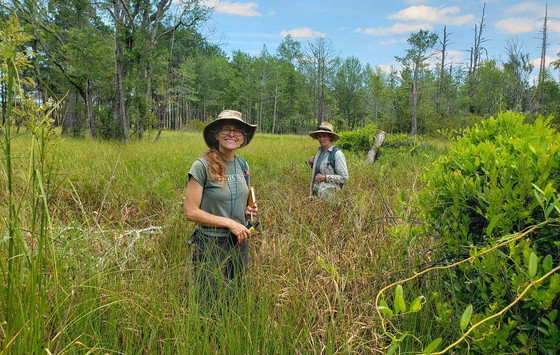 DNR botanists assess endangered pondberry at Sandhills WMA (Nathan Klaus/DNR)
Other headlines worth mentioning:
- A DNR-led partnership to sample, grow and save 14 imperiled plant species landed a nearly $780,000 federal grant.
- The spread of Joros, the big East Asian spiders first documented on this continent in north Georgia, stirred comments and concern.
- Although not breaking news, Out My Backdoor columnist Terry W. Johnson provided insights that interested hundreds with this birdfeeder’s guide to suet.
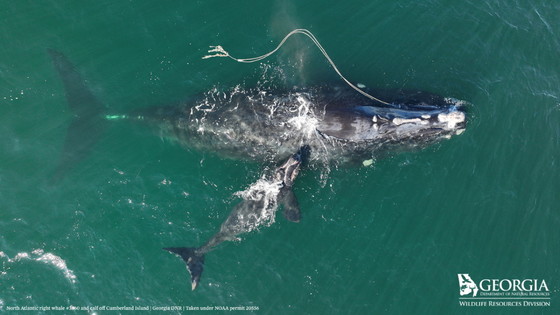 DNR video of Snow Cone and calf off Cumberland Island (taken under NOAA permit 20556)
Calving season for one of Earth’s most endangered large whales has started off with a bang. The highlights for North Atlantic right whales so far:
A right whale entangled in commercial fishing rope gave birth, and DNR drone video of the newborn swimming in and around the rope trailing from the mom’s mouth went worldwide. The mom, nicknamed Snow Cone, and her calf have been seen at least three times since. Although the calf is at risk of becoming caught and the entanglement threatens the mother’s health, researchers consider it too risky for the whales and responders to try to remove or shorten the rope.
Eight calves have been spotted, which is a good start. Last winter there were 18. But many more are needed. There are fewer than an estimated 350 North Atlantic right whales left and the species is declining as deaths outpace births.
Following the death of a calf hit by a sport fisher off Florida’s St. Augustine inlet in February, DNR, Florida Fish and Wildlife Conservation Commission and NOAA redoubled efforts to raise awareness among recreational boaters about the risks of running into a right whale (article). Since 2005, there have been five reported incidents in the Southeast. But injuries and scars on right whales point to more.
A group of anglers experienced the unforgettable off the South Carolina coast when a right whale and her calf surfaced nearby. “This is amazing,” said one as another captain began videoing the encounter, according to Charleston’s The State.
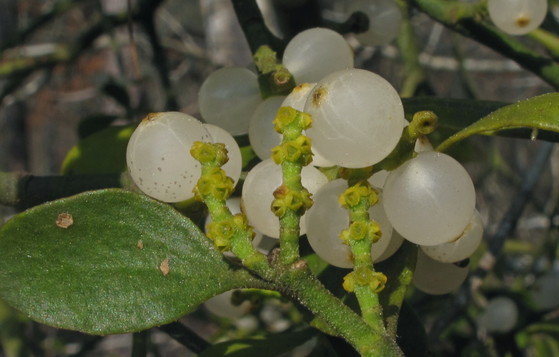 Mistletoe berries (Alan Cressler)
By TERRY W. JOHNSON
With Thanksgiving, Black Friday and Cyber Monday behind us, it is time to begin focusing our attention on Christmas … and beyond buying gifts.
For example, during this season we decorate our homes with a small group of plants we consider Christmas plants. Along with evergreen trees and poinsettias, this select list includes mistletoe.
But the mistletoe growing in hardwoods in our yards is far more than a magical Christmas plant. It is a valuable source of food for wildlife. And it’s one of the most unlikely plants associated with the holiday. …
Read the rest of Terry’s column for fascinating insights into mistletoe.
Terry W. Johnson is a retired DNR program manager and executive director of TERN, the Wildlife Conservation Section’s friends group. Check out past columns, his Backyard Wildlife Connection blog and his book “A Journey of Discovery: Monroe County Outdoors.” Permission is required to reprint his columns.
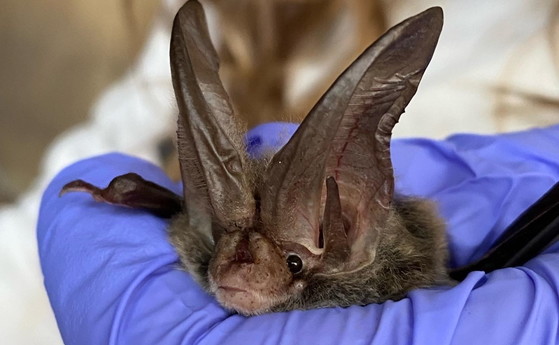 Rafinesque’s big-eared bat found in a south Georgia culvert (Emily Ferrall/DNR)
Bat surveys of road culverts for white-nose syndrome and use of the hibernacula found a Rafinesque’s big-eared bat in south Georgia and 217 tri-colored bats at the species’ largest known culvert roost in the state. The latter marked the most bats seen at the site since DNR began checking it in 2019.
Berry College’s bald eagle nest is in prime time again, with two eggs and thousands watching the live video feed of the nest. With the eggs laid early this month, pip watch is set for the first half of January.
Recovering America's Wildlife Act soared through a U.S. Senate Environment and Public Works review this month. The hearing (video) marked another milestone for the legislation aimed at providing states vital funding – without increasing taxes – to conserve 12,000-plus high-priority species. Georgia’s proposed projects.
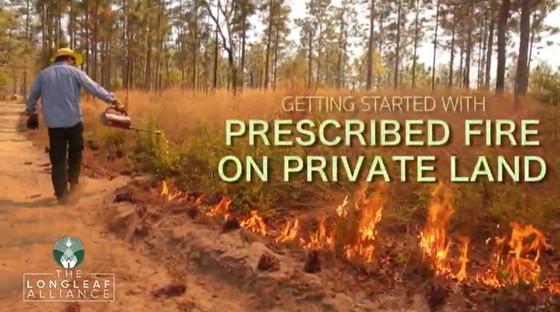 Georgians new to using prescribed fire on their property should watch The Longleaf Alliance’s “Getting Started with Prescribed Fire on Private Lands.” The new video, which includes DNR fire safety officer Shan Cammack as producer, features the experiences of Georgia tree farmers and prescribed burners, as well as details on key resources for private landowners.
A sixth year of satellite-tracking manatees on Georgia’s coast provided DNR and Clearwater Marine Aquarium more data on how the hefty mammals use habitats and migrate back and forth between Florida. For example, the three tagged manatees that made it to Georgia in 2021 all used the Atlantic Ocean during part of their return south in the fall, with one swimming as far as eight miles offshore.
Most of Georgia’s manatees winter along Florida’s central Atlantic coast, where a die-off in sea grass made the area ground zero for manatee deaths last winter. So far in 2021 more than 1,000 sea cows – a 10th of Florida’s estimated population – have died, spurring a state and federal response supporting rescues, assessments and even a trial with supplemental feeding in Indian River Lagoon this winter.
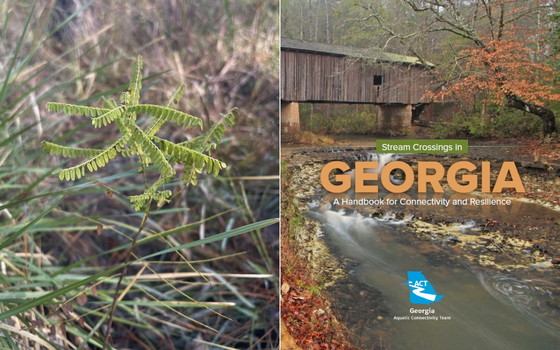 Georgia lead-plant (left) and the new Stream Crossings in Georgia handbook
Quick hits:
- A newly discovered population of state-endangered Georgia lead-plant – and only the third in the state – has been found on private land.
- The Georgia Aquatic Connectivity Team has released the second edition of Stream Crossings in Georgia, a guide to installing stream-crossing structures that allow aquatic and terrestrial wildlife to pass.
- Gov. Brian Kemp presented DNR’s Sgt. Tony Cox and Game Warden K.P. Boatright the Act of Heroism Award for saving an overturned boater on Lake Seminole in freezing rain and wind Christmas Eve 2020.
- Great blue herons prey on many things, but grabbing a sizable juvenile alligator might have seemed a reach for all but this ambitious blue.
WHAT YOU MISSED ...
In the previous Georgia Wild:
- Hognose drama
- Looking for monarchs
- A fall splash of sassafras
"Entangled whale spotted off Cumberland Island with new calf," The Current, and others via AP. Also: Canadian Broadcasting Corp., Southern Living.
"How you can help count Georgia's monarch butterflies," Axios, and others including WABE-FM (90.1, Atlanta)
"Invasives from beyond: attack of the mussels," U.S. Fish and Wildlife Service
"Conserving predators of the plant kingdom," Discover
"Manatees are starving; wildlife agencies scramble to save them," Georgia Public Broadcasting
(+video) "COVID-19 infected deer could act as ‘reservoirs,’ study suggests," WAGA-TV (Ch. 5, Atlanta)
"To see where a whale has been, look in its mouth," Scientific American
"High court keeps limits on lobster fishing to protect right whales," The Associated Press
"Invasive tegus survive Florida cold, eat tortoise young," Tampa Bay Times and others via AP
"Forty percent of right whale population use Gulf of Saint Lawrence," Phys.org
"Turkeys bathe in ants for protection," WSB-TV (Ch. 2, Atlanta) on DNR Facebook post
"Oaks are most wildlife-friendly trees of all," The Atlanta Journal-Constitution
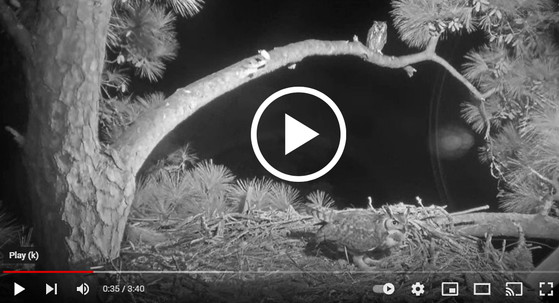 "Great Horned Owl Pair Visits Savannah Nest," Landings Bird Cam
Leucistic squirrel, DNR Law Enforcement Division
"20,000 Whimbrels Take Refuge on Tiny S.C. Island," The Cornell Lab
"Species Profile: Eastern Rat Snake," U.S. Department of Defense
CREDITS
Masthead: Entangled right whale 3560 ("Snow Cone") and calf off Cumberland Island (DNR/taken under NOAA permit 20556
Top
|